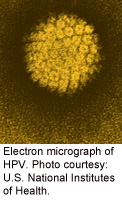
THURSDAY, Dec. 15 (HealthDay News) – To catch cervical cancer or the lesions that can lead to it, a human papillomavirus (HPV) test is the best option for women over 30, Dutch researchers report.
Using it in conjunction with the more traditional Pap smear resulted in earlier detection of precancerous lesions and prevented more cervical cancers from developing, said study author Dr. Chris Meijer, a professor of pathology at VU University Medical Centre in Amsterdam.
The study is published online Dec. 15 in The Lancet Oncology.
Nearly all cervical cancers are caused by HPV, a virus spread through sexual intercourse. Some HPV strains are more strongly linked with the cancer than others.
The superiority of HPV testing over traditional Paps at finding precancerous cervical lesions is established, Meijer noted. However, his team wanted to see if HPV testing also offered better protection and detection long-term — in two screenings done over a five-year period.
They found it did.
While five years may sound like a long lag time between screenings, it is not, he said. “The Netherlands already has a screening interval of five years, starting from 30 years of age until 60 years,” he said. The program is inexpensive and effective, he added.
In the study, Meijer’s team evaluated nearly 45,000 women, aged 29 to 56. Women in one group got a traditional Pap smear and an HPV DNA test. The women in the other group got just the Pap test.
Five years later, all women got both tests.
The researchers looked to see whether HPV tests resulted in fewer high-grade cervical lesions and cervical cancer in the second screening, due to earlier detection and treatment.
In the first screen, the HPV tests found more of the early changes that can precede cervical cancer than the Pap smear alone did.
Five years later, far fewer women in the HPV group had more advanced lesions or cervical cancer than did the Pap-only women.
Four women in the HPV/Pap group were diagnosed with cervical cancer, while 14 in the Pap-only group were.
When they looked at cervical cancer or advanced lesions, 88 in the HPV arm of the study were diagnosed with one or the other compared to 122 in the Pap-alone arm.
The improved protection against advanced lesions, the researchers said, is due to the earlier detection of the precursor lesions. When they were treated, it helped prevent them from progressing.
In an accompanying commentary, scientists from the U.S. National Cancer Institute wrote that the Dutch trial does show the five-year screening interval is safe. But they added that it is unclear if the same results would hold true in a different population with different testing guidelines.
The HPV test can be done using the same specimen collected for the Pap test, Meijer said.
Costs of the tests differ. Meijer said Pap smears are about $38 in the Netherlands, while an HPV test costs about $64. However, the Dutch Minister of Health recently recommended lowering the cost of an HPV test to below that of the traditional Pap.
The new study is “further defining how we can incorporate HPV testing into our screening program,” said Dr. Elizabeth Poynor, a gynecologic oncologist and pelvic surgeon at Lenox Hill Hospital, in New York City.
She noted that she doesn’t think the HPV screen will replace the Pap test completely. “It may turn out to be a first-line screen. Stay tuned for more,” she said. “Certainly ask your physician if you’ve had HPV.”
In October, three U.S. cancer groups proposed new guidelines for cervical cancer testing, extending intervals between screenings and making other changes. These guidelines, issued by the American Cancer Society and others, call for combination HPV/Pap smear testing for women aged 30 and older.
After three normal Paps, women over 30 can have the test ever two to three years, according to the American Cancer Society.
However, the U.S. Preventive Services Task Force remains cautious about the use of the HPV test, standing by the Pap as the best bet for now.
The Dutch study was funded by Zorg Onderzoek Nederland (the Netherlands Organization for Health Research and Development).
More information
To learn more about cervical cancer, visit the U.S. National Institutes of Health.

